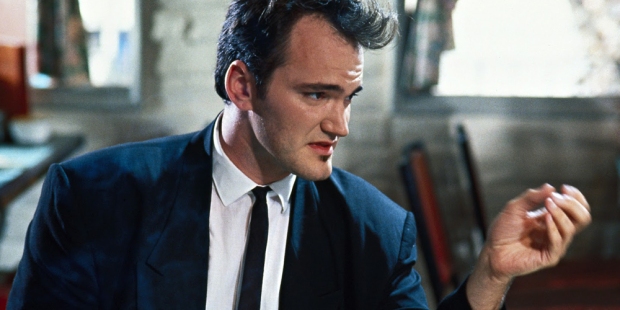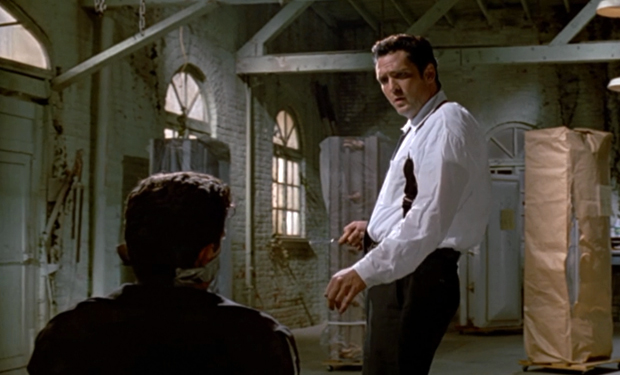What I’m about to post is an English translation of a part of the favourite essay I have written by now. I chose this topic as an assignment for a class called Media and Violence. The essay is all about my favourite American director Quentin Tarantino, also, this particular piece of it focuses mostly on the analysis of screen violence and it’s influence on the viewer in Tarantino’s first-born, the legendary Reservoir Dogs. The main question inflicts itself: was all that blood really necessary?
The formal expression most commonly attributed to the work of director Quentin Tarantino is the aestheticization of violence. The inevitable violence is also the central topic for the biggest critics and those who disapprove his work. The term aestheticization of violence includes all kinds of violent behaviour or images that suggest violence in high culture and mass media; violence which is presented in movies, fashion, TV shows and the rest of the media world.

Tarantino as Mr. Brown in Reservoir Dogs
When it comes to art, the aestheticization of violence and death is very much present since the early age, especially in the western culture. Why has violence always been such an important part of art, cultural critic Susan Sontag explains as the universal human desire for images of pain and violence, it is the same as our universal desire for looking at the naked bodies. Sontag also thinks that people feel a certain amount of satisfaction while watching that kind of content because they feel they can take it without wanting to look away. In case they do look away, they feel satisfied, but in a different way. Kind of like a win-win situation.
Of course, an abundance of violent scenes is not something typical for Tarantino’s movies only, there is a great number of directors who use it, I will mention the most memorable ones like David Lynch, Guy Richie and Ridley Scott. Hollywood cinematography is present in the entire world, produces the most violent movies, but also attributes most to the aestheticization and presentation of violence as a form of artistic expression.
The critics have different opinions about the aesthetics of violence, there are two main theories most of the talk about: the habituation theory and the catharsis theory. The habituation theory suggest that the more we consume violent content in movies or TV shows, we decrease our sensibility to violence, violent behaviour becomes normal and usual to us. It is often presumed that movie violence is superficial and senseless, it is used only to get the attention, and eventually has a negative influence on the audience who’s members can become violent themselves.
The opposed side considers violence to be a part of the content, important asset to the movie’s plot, it has a chatartic effect on the viewer who’s tendency for violent behaviour decreases. Australian movie critic Adrian Martin defends and explains the use of violence in the movies: „ … violence on-screen is not real and mustn’t be confused with real life violence. Movie violence is fun, spectacular, acted, it is a dramatic metaphor. (…) It has gone through its historical changes, has its codes, precise aesthetic benefits.”
Now it’s time to apply the theory through the examples, and my first pick was my favourite Tarantino movie which was also his first, break through project from 1992 – Reservoir Dogs.
This influential piece of independent movie history tells a seemingly simple story: it begins with eight men who don’t know each other (they don’t even reveal their names or anything about their identity) who have planned a diamond robbery, but the whole deal doesn’t really go as smoothly as they’ve expected. Nonlinear narrative combined with many gore, bloody scenes leads the viewer through the story and gets him to know the characters.
Those violent scenes and extent use of profanities were the reason for a big discussion right after the movie premiered. While some were impressed with the scenery and amazing acting performances, some scenes were too much to handle for a part of the audience. The scene that cause the biggest ‘fuss’ is the one with Mr. Blonde (played by Michael Madsen) dancing and having loads of fun while brutally torturing a policeman by cutting his ear off. On many occasions the viewers would leave the cinema because of this particular scene. On the other hand, it has become one of the iconic scenes of the modern cinema, along with the song Stuck in the Middle with You performed by the Stealers Wheel.

The infamous ‘ear scene’ with Michael Madsen
Tarantino’s answer to the numerous question about how Reservoir Dogs could inspire the increase of violence among its viewers went a little like this: Well, you can’t arrest me for something some pussy could do after he watches the movie. The moment when artists are blamed for stuff like that, that doesn’t have anything to do with art anymore.
Along with that, there are also negative comments concerning political (in)correctness – the movie is filled with aggressive racist dialogs, demeaning conversations towards women, and there’s also an important fact – there is not a single female role in the movie. To explain the racist part, all the criminals are white males, in this case they are the ones who have adopted the cool gangster image.
Verbal violence and overuse of profanities has become a common trade of Tarantino’s movies, in Reservoir Dogs he implemented swear words wherever it was possible (fuck is pronounced 269 times), we could assume it was his way of attracting attention and desire to bring something new to the crime movie genre. At the time those movies were getting less and less popular, Tarantino is the one that renovated the genre and brought it back to life. The critics love to say that Tarantino glorifies violence, tries to make it seem appealing, but closer look at those stylized scenes and pop culture references bring us to a different conclusion. Violent scenes are exaggerated, choreographed, attention consuming, but they are very far from reality.
Stylization that is created on exaggeration and repetition keeps the viewer in the safe distance, the difference between the real and imaginary world is very clear. We have our world on one side, and Tarantino’s creations on the other. If you appreciate his creation, enjoy it, if not, don’t watch it and just let him be.
Fantastic post. Have you shared this on any movie websites?
LikeLike
Thank you very much! 🙂 I haven’t shared it anywhere (yet), only posted it here.
LikeLiked by 1 person
Oh cool! Is it something that interests you? If so, let me know if you would like to get some writing up on Moviepilot! Samuel.harries@moviepilot.com
LikeLiked by 2 people
Of course I’m interested, that sounds awesome! 🙂 I will send you an email. Btw, English is not my first language, I hope that’s not a problem.
LikeLiked by 1 person